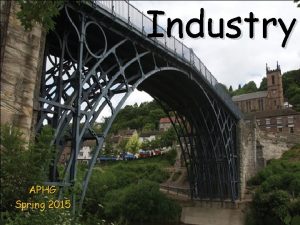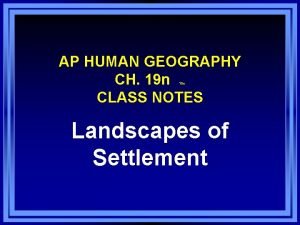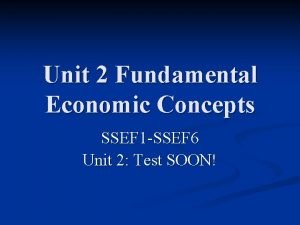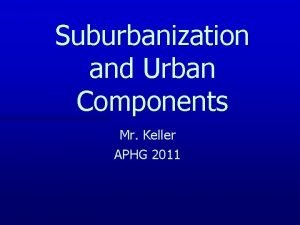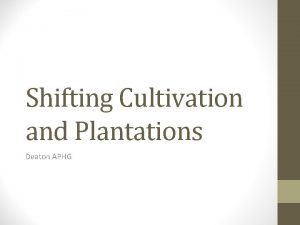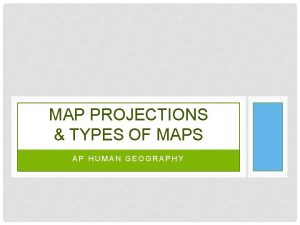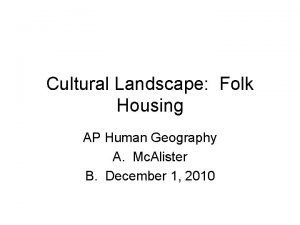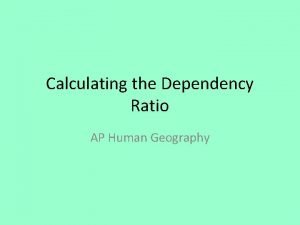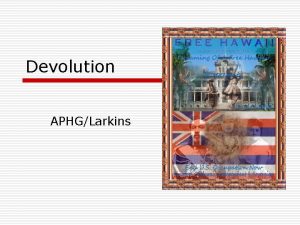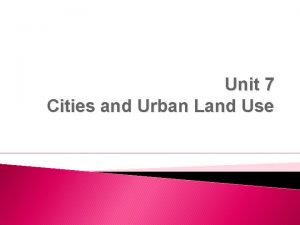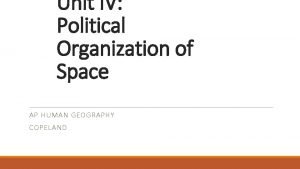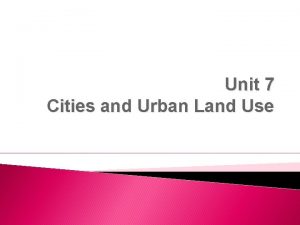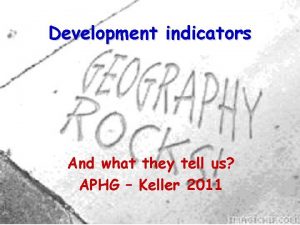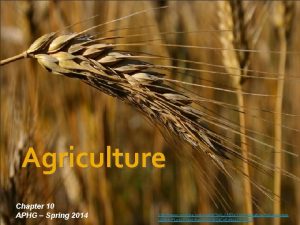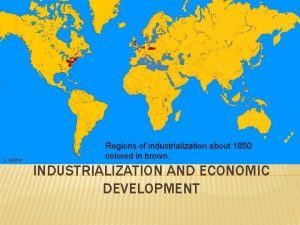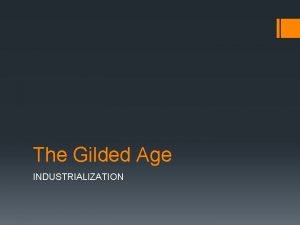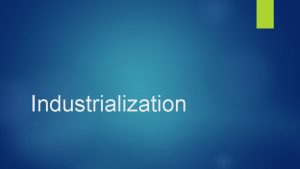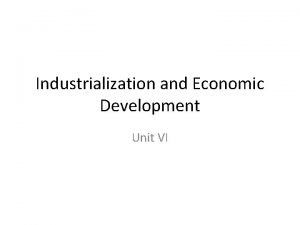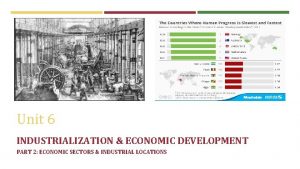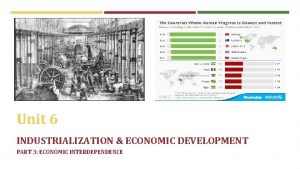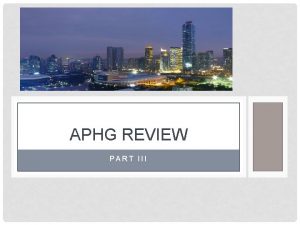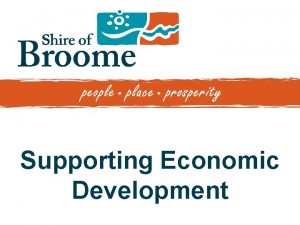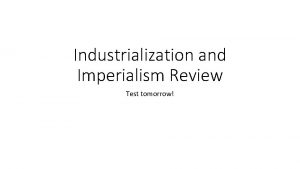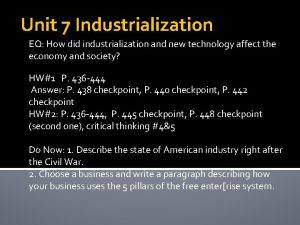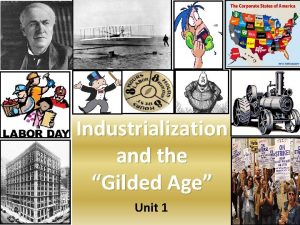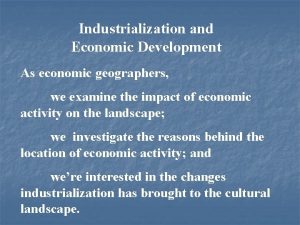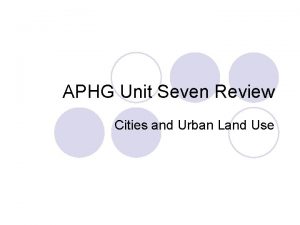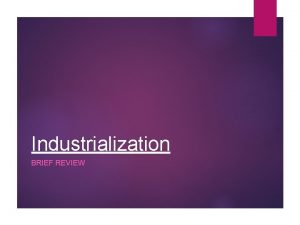APHG Unit Six Review Industrialization and Economic Development





















- Slides: 21

APHG Unit Six Review Industrialization and Economic Development

Economic Development o o o Industrialization: the process evolved from taking basic goods from the earth, and processing them into finished goods n Industrial Revolution: began in England in the late 1700 s Economic Development: improving the conditions of people through diffusion of knowledge and technology n More Developed Countries (MDCs): n Less Developed Countries (LDCs): n Newly Industrialized Countries: somewhere in the middle Compressed modernity: rapid economic and political change that transform a country into a stable nation

Economic Indicators of Development o o o Gross Domestic Product per Capita: MDC-Higher Types of Jobs: MDC-Tertiary, LDC-Primary Worker Productivity: MDC-More productive n Value Added: subtracting the costs of raw materials and energy from the gross value of the product Access to Raw Materials: MDC-More access Availability of Consumer Goods: MDC-More Available Social Development: literacy, formal education, and good health care

Theories of Economic Development o o Modernization Model: According to Weber, the cultural environment of Western Europe favored change; tradition is greatest barrier to modernization Dependency Theory: responsibility for poverty on wealthy nations; Wallerstein n Core Countries: rich nations that fuel world’s economy n Semi-Periphery Countries: exert more power than peripheral countries, but are dominated by core countries n Periphery Countries: low income countries hindered by colonization

Rostow’s Model § Economic prosperity is open to all countries • • Traditional Stage: build lives around families, communities, and religion; limited wealth; subsistence farmers Take-off Stage: countries began experimenting with trade; industrial revolution; individualism, willingness to take risks, and material goods Drive to technological maturity: economic growth is accepted; higher standard of living; economy diversifies; BR declines High mass consumption: mass production of goods; luxury goods become necessities; high incomes and more people in tertiary sector

Industrial Revolution o o Began in Britain, spread through Europe and Russia, then to the United States Early factories in Britain were powered by water running downslope n o James Watt: inventor of the steam engine; water can be pumped more efficiently; more flexible use of machines Break-of-bulk: transfer of cargo from one type of carrier to another

Location Theory o Why is what produced where? n n n Variable Costs: energy, labor, and transportation is less expensive in some areas Friction of Distance: cost of transportation increases with distance Decay: industries are more likely to serve markets of nearby places than those far away

Weber’s Least Cost Theory o Developed by Weber as an attempt to explain the location of secondary industries n Transportation: site of factory is determined based on costs of moving raw materials to the factory, and then to the market n Labor: cheap labor may make up for high transportation costs n Agglomeration: if several industries cluster, they can share talents, services, and facilities o o Deglomeration: occurs when a business moves from a crowded area Substitution Principle: business owners can juggle expenses, as long as not all their costs go up at once

Hotelling’s Model o o o Harold Hotelling (1895 -1973) was an economist who built on Weber’s model He wanted to understand locational interdependence Asked what two ice cream vendors would do on a beach n n Said they would begin at opposite ends, and then gradually end up back-to-back Once there, they would be unlikely to move

Hotelling Interdependence Theory o o influence of one firm’s locational decisions by locations chosen by its competitor Variable Revenue Analysis: the firm’s ability to capture a market that will earn it more customers and money than its competitor

Site o o Particular to a geographic location and focus on varying costs of land, labor, and capital Labor Intensive Industries: an industry heavily dependent on labor like a textile industry

Situation • In Industrialization, has mostly to do with transportation costs • • • Bulk-reducing industry: the raw materials are bulkier and heavier than the finished products; example: copper industry Bulk-gaining industry: raw materials weigh less than the finished products; example: canning industry Single-market manufacturing: manufacturing clusters near its market

Major Industrial Regions o o The distribution of industries around the world are very uneven Primary Industrial Regions: areas of large agglomeration of industry n n n Western and Central Europe: Ruhr River area of Germany (proximity to markets, raw materials, and transportation) Eastern North America: Manufacturing Belt extends from Boston and New York to Philadelphia and Baltimore, and borders Great Lakes Russia and the Ukraine: Ukraine provides coal; Trans. Siberian Railroad; Ural Mountains

Major Industrial Regions o Primary Industrial Regions: n Eastern Asia: o Japan: 1 st country in East Asia to industrialize; never colonized n n n o Meiji Restoration: campaign for modernization and colonization Oligarchs: industrial and military leaders; established colonies Kanto Plain: includes Tokyo and surrounding areas; Tokyoforward capital China: began industrializing under communism n Northeast District: industrial heartland in Manchuria; large deposits of coal and iron

Major Industrial Regions o Primary Industrial Regions: o Four Tigers: (South Korea, Taiwan, Hong Kong, and Singapore) n o o Export-oriented industrialization: directly integrate their economies into the global market by concentrating on producing goods for export; example: electronics Pacific Rim: countries that border the Pacific Ocean on their eastern shores Special Economic Zones: found in China; foreign investment is allowed and capitalistic ventures encouraged

Secondary Industrial Regions • Lie south of the Primary Industrial Regions • Venezuela, Argentina, Brazil, South Africa, Nigeria, Ganges River area of India, Malaysia, and southern Australia • • • Maquiladoras: developed in 1960’s in Mexico, just south of the US border; goods manufactured for export to the US NAFTA: agreement between US, Canada, and Mexico • Pros: promote trade between countries • Cons: Mexico’s standard of living and wages India: • Natural Resources: hydroelectric power, iron, and coal • Human Resources: HUGE population becoming more educated and westernized

Global Inequalities o Challenges for MDCs n Trade Blocs: conglomeration of trade among countries within a region o o o n n n North America: NAFTA European Union: European Union East Asia: No formal agreement yet…Four Tigers? Transnational Corporations: companies that operate in countries other than the ones in which they are headquartered Conglomerate Corporations: comprised of many small firms that support the overall industry Deindustrialization: decrease of employment in manufacturing as a share of total employment

Global Inequalities o Challenges for LDCs n n n Distance from markets: invest in transportation facilities like airports Inadequate infrastructure: lack transportation, communications, schools, and universities Competition with existing manufacturing in other countries: transnational competition; low-skilled jobs in LDCs, high-skilled jobs in MDCs o New international division of labor: keeps global inequalities in place; discourages new industries, keeps high-skilled jobs in MDCs, and prevents wealth from flowing to LDCs

Industrialization and the Environment o o Fossil Fuel Reserves: n Proven Reserves: oil reserves that have been found, but not extracted n Potential Reserves: unknown number Consumption of Fossil Fuels: n MDCs have about ¼ of the world’s population, but use ¾ of the world’s fossil fuels n China uses the most fuel, followed by the United States

Industrialization and the Environment o o Industrial Pollution: increased air, water, and land pollution n Global Warming: increase in Earth’s temperature caused by the burning of fossil fuels n Greenhouse Effect: an anticipated warming of the Earth’s surface that could melt the polar icecaps n Acid Rain: forms when sulfur dioxide and nitrogen oxides are released in the atmosphere by burning fossil fuels Sustainable Development: people living today should not impair the ability of future generations to meet their needs

Solutions to Environmental Problems o o Prevention: Chinese One-Child Policy; Debt-for. Nature Swap Technological Change: includes recycling of industrial wastes Mitigation: damage may be undone or reduced once it has occurred Compensation: political bodies may negotiate compensation for those negatively impacted by industrial waste; ex: Erin Brokovitch
 Industrialization aphg definition
Industrialization aphg definition What is economic growth and development
What is economic growth and development Economic growth vs economic development
Economic growth vs economic development Unit 10, unit 10 review tests, unit 10 general test
Unit 10, unit 10 review tests, unit 10 general test Township and range ap human geography
Township and range ap human geography Metes and bounds aphg
Metes and bounds aphg Unit 1 review fundamental economic concepts answers
Unit 1 review fundamental economic concepts answers Suburbanization definition aphg
Suburbanization definition aphg Shifting cultivation ap human geography
Shifting cultivation ap human geography Human geography types of maps
Human geography types of maps New england housing styles ap human geography
New england housing styles ap human geography What is dependency ratio in ap human geography
What is dependency ratio in ap human geography Topographic map definition ap human geography
Topographic map definition ap human geography Aggregation ap human geography
Aggregation ap human geography Sex ratio aphg
Sex ratio aphg Devolution aphg
Devolution aphg Bidrent theory
Bidrent theory Compact states examples
Compact states examples Sprawl aphg
Sprawl aphg Semi periphery ap human geography
Semi periphery ap human geography Intensive subsistence agriculture aphg
Intensive subsistence agriculture aphg Classify each polygon
Classify each polygon
